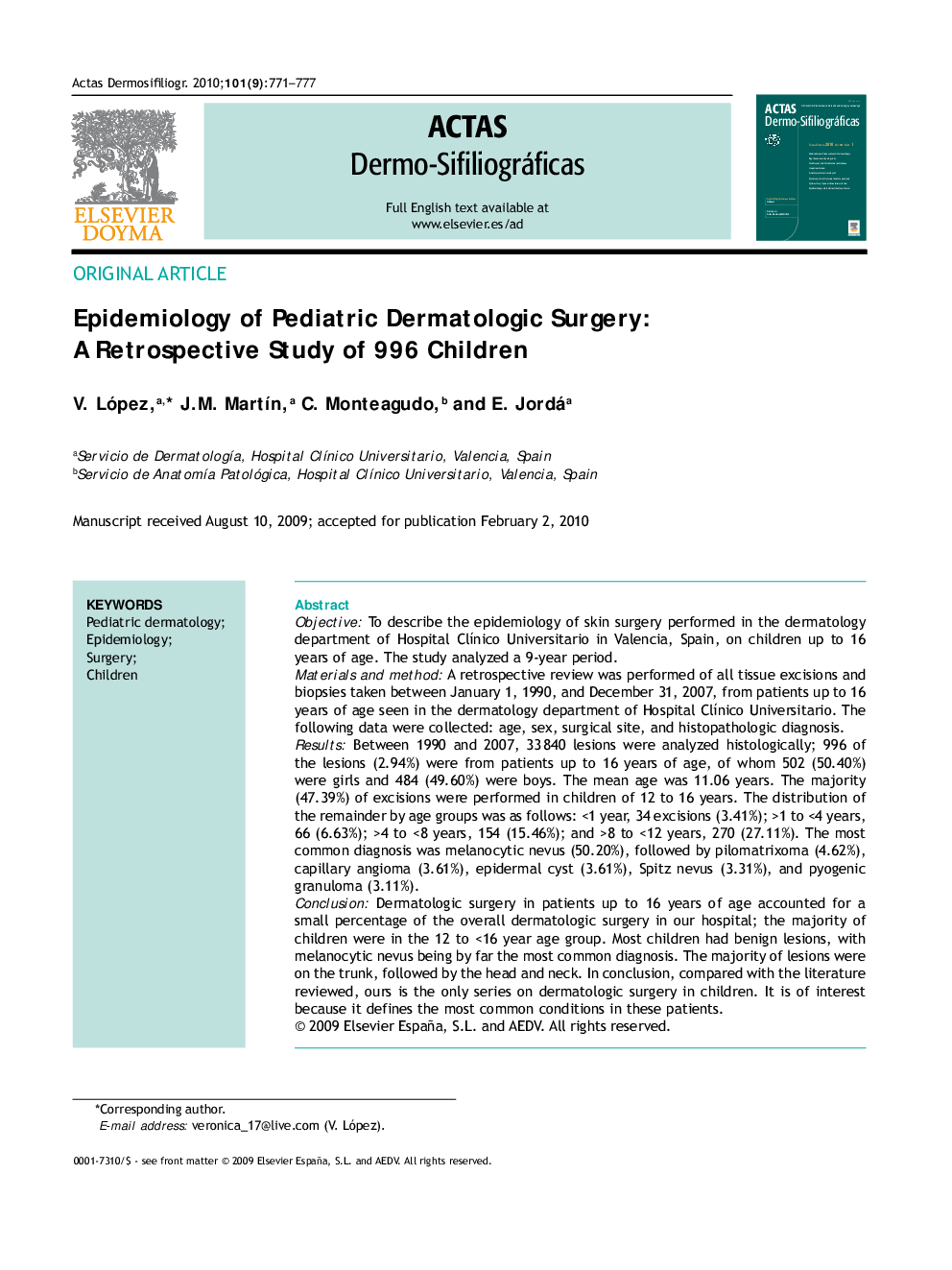| Article ID | Journal | Published Year | Pages | File Type |
|---|---|---|---|---|
| 3183614 | Actas Dermo-Sifiliográficas (English Edition) | 2010 | 7 Pages |
ObjectiveTo describe the epidemiology of skin surgery performed in the dermatology department of Hospital Clínico Universitario in Valencia, Spain, on children up to 16 years of age. The study analyzed a 9-year period.Materials and methodA retrospective review was performed of all tissue excisions and biopsies taken between January 1, 1990, and December 31, 2007, from patients up to 16 years of age seen in the dermatology department of Hospital Clínico Universitario. The following data were collected: age, sex, surgical site, and histopathologic diagnosis.ResultsBetween 1990 and 2007, 33 840 lesions were analyzed histologically; 996 of the lesions (2.94%) were from patients up to 16 years of age, of whom 502 (50.40%) were girls and 484 (49.60%) were boys. The mean age was 11.06 years. The majority (47.39%) of excisions were performed in children of 12 to 16 years. The distribution of the remainder by age groups was as follows: <1 year, 34 excisions (3.41%); >1 to <4 years, 66 (6.63%); >4 to <8 years, 154 (15.46%); and >8 to <12 years, 270 (27.11%). The most common diagnosis was melanocytic nevus (50.20%), followed by pilomatrixoma (4.62%), capillary angioma (3.61%), epidermal cyst (3.61%), Spitz nevus (3.31%), and pyogenic granuloma (3.11%).ConclusionDermatologic surgery in patients up to 16 years of age accounted for a small percentage of the overall dermatologic surgery in our hospital; the majority of children were in the 12 to <16 year age group. Most children had benign lesions, with melanocytic nevus being by far the most common diagnosis. The majority of lesions were on the trunk, followed by the head and neck. In conclusion, compared with the literature reviewed, ours is the only series on dermatologic surgery in children. It is of interest because it defines the most common conditions in these patients.
ResumenObjetivoRealizar un análisis epidemiológico de la cirugía dermatológica realizada en pacientes menores de 16 años en el servicio de dermatología del Hospital Clínico Universitario durante un período de 9 años.MétodoSe revisaron retrospectivamente todas las extirpaciones y biopsias de pacientes menores de 16 años desde 1 enero de 1999 al 31 de diciembre de 2007 en el servicio de dermatología del Hospital Clínico Universitario de Valencia. Los datos recogidos incluían las siguientes variables: la edad del paciente, el sexo, la localización y el diagnóstico histopatológico.ResultadosDentro de este período, se analizaron histológicamente 33.840 lesiones. De ellas, 996 (2,94%) correspondieron a pacientes de ≤ 16 años. De las 996 piezas analizadas 502 (50,40%) correspondían a mujeres y 494 (49,60%) a varones. La edad media fue 11,06. El mayor número de exéresis se situó entre los 12 y los 16 años (47,39%). La distribución del resto de extirpaciones por grupos de edad fue la siguiente: ≤ 1 año 34 extirpaciones (3,41%), de > 1 a ≤ 4 años: 66 (6,63%), de > 4 a ≤ 8 años: 154 (15,46%) y de > 8 a ≤ 12 años: 270 (27,11%). El diagnóstico más frecuente fue el de nevus melanocítico (50,20%), seguido del pilomatricoma (4,62%), el angioma capilar (3,61%), el quiste epidérmico (3,61%), el nevus de Spitz (3,31%) y el granuloma piogénico (3,11%).ConclusiónEn nuestra serie, la cirugía dermatológica en menores de 16 años constituye un pequeño porcentaje de la cirugía dermatológica que se realiza en nuestro hospital, siendo el grupo de mayor edad el más frecuente. En la edad pediátrica, la patología benigna representa el mayor número de diagnósticos, siendo con mucho los nevus melanocíticos la patología más frecuente. El mayor número de lesiones se ha encontrado en el tronco, seguido por la cabeza y el cuello. En conclusión, de la literatura revisada, nuestra serie es la única en lo referente a la cirugía dermatológica en la edad pediátrica, siendo de interés para conocer la patología que con mayor frecuencia se analiza en estos pacientes.
